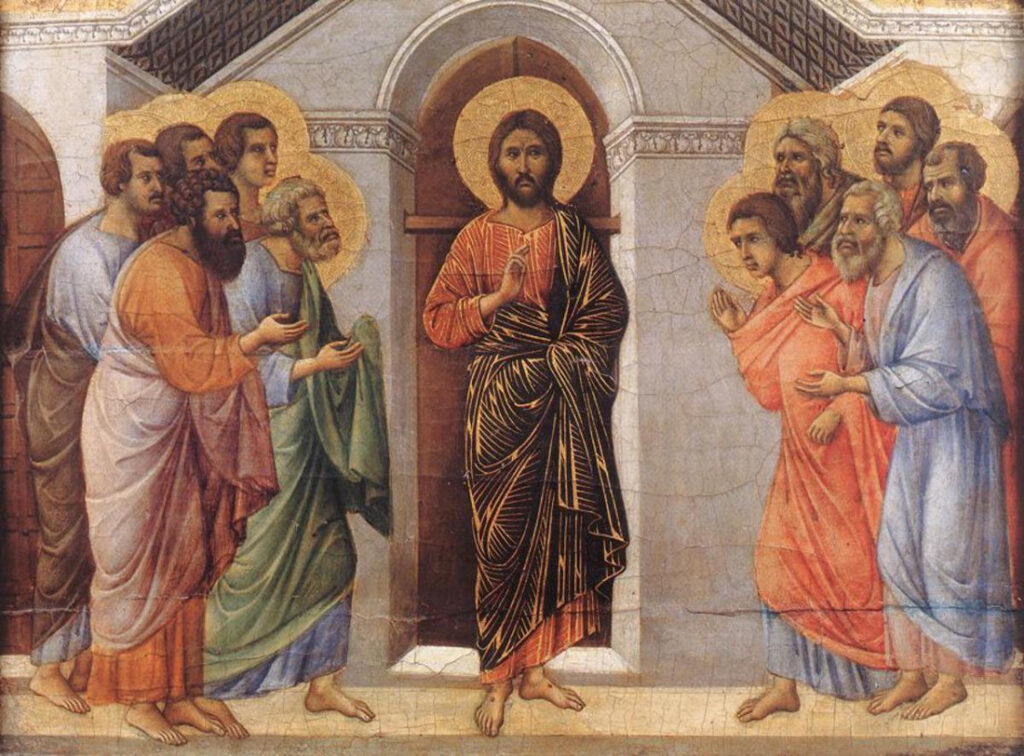Cantata 42 was composed for the first Sunday after Easter in 1725, and gets its title from the first line of the Gospel reading for that day, John 20:19-31. We don’t know who wrote the libretto, however they certainly drew from several sources in the process: the second movement is taken literally from the John’s Gospel; movement 3 elaborates on a quote from Matthew 18:20; movement 4 comes from a chorale text by Jacob Fabricius from 1632. Movements 5 and 6 are fully original, and movement 7 is a juxtaposition of two hymns: the first one by Martin Luther (1529) and the second one by Johann Walter (1566).
As a whole, the libretto conveys the message of the resurrected Christ as the “shield” guarding his followers from persecutors, and ends with a prayer for peace.
The cantata is scored for 2 oboes, bassoon, strings, 4-part choir and continuo, calling for the 4 solo voices as well.
It opens with a Sinfonia which could have come from a secular work from the Cöthen period, now lost, catalogued as BWV 66a. The reeds are treated as a concertino group against the strings, passing a similar theme back and forth, except at the beginning of section B, in which the oboes have a sweet “cantabile” line for a few bars before resuming the initial motif.
The next two movements conform a recitive/aria pair. The recitative is for the tenor, and it delivers the text from John’s Gospel, chapter 20 verse 19. The continuo line is scored with the bassoon in sixteenth notes over the violone and organ, creating a pulsating effect illustrative of the “fear of persecution”. In contrast, the alto aria that follows displays an almost supernatural stillness as it evokes Jesus’ promise of being present whenever two or three people gather in his name. The full orchestra accompanies the voice. It features an extensive “A” section marked “Adagio” in 4/4 meter, in which the broad melodic lines are punctuated by alternating triplets in the two oboes. The “B” section changes meter to 12/8 with another tempo marking, “Un poc’ andante”, in which the orchestra drops out except for the bassoon and continuo.
Movement 4 is a delightful duet for soprano and tenor, accompanied by bassoon and continuo. In spite of being set to a hymn text, there aren’t any direct references to the original chorale melody.
The next recitative / aria pair is for the bass, in which the libretto summarizes the message of Jesus assuaging the disciples’ fears of their prosecutors. The recitative is secco, except for a bit of word painting towards the end on “laßt die Feinde wüten” (“let the enemies rage”). The aria calls for divisi first violins (not enough skill in his second violins, perhaps?) and continuo. All instrumental lines have busy passagework in 16th notes throughout, contrasting with the calmer line of the voice, which reserves the 16th notes for the “persecution” (“Verfolgung”).
The double-stanza chorale brings about opportunity for some interesting harmonic turns to highlight specific lines (like “we might lead a quiet and peaceful life”, with the pedal point over “stilles”), and a delightful “Amen” to conclude the cantata.
